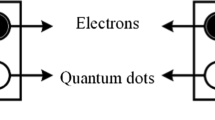Abstract
Quantum dot gate FETs (QDGFET) produce one intermediate state between two stable on and off states due to the change in the threshold voltage. A circuit model based on Berkeley Short-channel IGFET Model (BSIM) that accounts for this intermediate state is developed. Different ternary logics such as ternary logic inverter, MAX-MIN functions, multiplier, comparator, etc. can be implemented using QDGFETs. In this work the designs of ternary logic AND and OR gate based on QDGFET is introduced. Increased number of states in three state QDGFETs will increase the number of bit handling capability of this device and will help to handle more bits at a time with less circuit elements.
Similar content being viewed by others
References
Ackermann R (1967) An introduction to many-valued logics. Routledge and Kegan Paul, London
Rescher N (1969) Many-valued logic. McGraw Hill, New York
Lin HC (1994) In: Proceedings of 24th IEEE international symposium multiple–valued logic. pp 188–195
Capasso F, Kiehl RA (1985) J Appl Phys 58:1366–1368
Tsai JH (2004) Solid State Electron 48:81–85
Imtiaz SMS, El-Ghazaly S (1998) IEEE Trans Microw Theory Tech 46:923–931
Raychowdhury A, Roy K (2004) In: Proceedings of international symposium on multiple-valued logic. pp 14–19
Balla PC, Antoniou A (1984) IEEE J Solid-State Circ 19:739–749
Karmakar S, Suarez E et al (2011) J Electron Mater 40:1749–1756
Karmakar S, Suarez E et al (2012) J Electron Mater 41:2663–2670
Karmakar S, Chandy JA et al (2012) J Electron Mater 41:2184–2192
Papadimitrakopoulos F, PhelyBobin T et al (1999) Chem Mater 11:522–525
Phely-Bobin T, Chattopadhyay D et al (2002) Chem Mater 14:1030–1036
Karmakar S, Gogna M et al (2012) Electron Lett 48:1556–1557
Karmakar S, Chandy JA et al (2013) IEEE Transactions on Very Large Scale Integration Systems (TVLSI) 21:793–806
Chandy JA, Jain F (2008) In: Proceedings of IEEE international symposium on multiple-valued logic. pp 186–190
Kleene SC (1938) J Symb Log 3:150–155
Kim YB (2011) Trans Electr Electron Mater 12:75–188
Author information
Authors and Affiliations
Corresponding author
Rights and permissions
About this article
Cite this article
Karmakar, S. Ternary Logic Gates Using Quantum Dot Gate FETs (QDGFETs). Silicon 6, 169–178 (2014). https://doi.org/10.1007/s12633-013-9175-x
Received:
Accepted:
Published:
Issue Date:
DOI: https://doi.org/10.1007/s12633-013-9175-x




